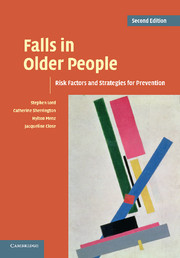Book contents
- Frontmatter
- Contents
- Preface
- Acknowledgements
- Part I Epidemiology and risk factors for falls
- 1 Epidemiology of falls and fall-related injuries
- 2 Postural stability and falls
- 3 Gait characteristics and falls
- 4 Sensory and neuromuscular risk factors for falls
- 5 Psychological factors and falls
- 6 Medical risk factors for falls
- 7 Medications as risk factors for falls
- 8 Environmental risk factors for falls
- 9 The relative importance of falls risk factors: an evidence-based summary
- Part II Strategies for prevention
- Part III Research issues in falls prevention
- Index
- References
1 - Epidemiology of falls and fall-related injuries
Published online by Cambridge University Press: 03 May 2010
- Frontmatter
- Contents
- Preface
- Acknowledgements
- Part I Epidemiology and risk factors for falls
- 1 Epidemiology of falls and fall-related injuries
- 2 Postural stability and falls
- 3 Gait characteristics and falls
- 4 Sensory and neuromuscular risk factors for falls
- 5 Psychological factors and falls
- 6 Medical risk factors for falls
- 7 Medications as risk factors for falls
- 8 Environmental risk factors for falls
- 9 The relative importance of falls risk factors: an evidence-based summary
- Part II Strategies for prevention
- Part III Research issues in falls prevention
- Index
- References
Summary
In this chapter, we examine the epidemiology of falls in older people. We review the major studies that have described the incidence of falls, the locations where falls occur and falls sequelae. We also examine the costs and services required to treat and manage falls and fall-related injuries. Before addressing these issues, however, it is helpful to briefly discuss four important methodological considerations that are pertinent to all research studies of falls in older people: how falls are defined, how falls are counted, how injurious falls are defined and what constitutes an older person.
The definition of a fall
In 1987, the Kellogg International Working Group on the Prevention of Falls in the Elderly defined a fall as ‘unintentionally coming to the ground or some lower level and other than as a consequence of sustaining a violent blow, loss of consciousness, sudden onset of paralysis as in stroke or an epileptic seizure’. Since then, many researchers have used this or very similar definitions of a fall. The Kellogg definition is appropriate for studies aimed at identifying factors that impair sensorimotor function and balance control, whereas broader definitions that include dizziness and loss of consciousness are appropriate for studies that also address cardiovascular and neurological causes of falls such as syncope, postural hypotension and transient ischaemic attacks.
- Type
- Chapter
- Information
- Falls in Older PeopleRisk Factors and Strategies for Prevention, pp. 3 - 25Publisher: Cambridge University PressPrint publication year: 2007
References
- 4
- Cited by



